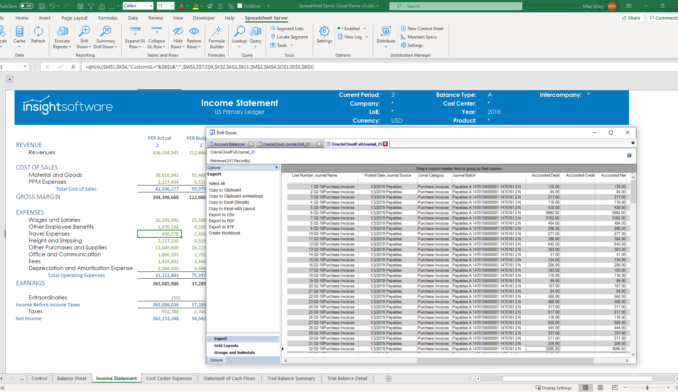Three Big Signs Your Financial Reporting Isn’t as Easy as it Should Be

In theory, business is pretty easy. You create a service or a thing that someone needs (or just flat out wants), and people give you money for it. If you make more money selling than you spend producing, you’re profitable and your business succeeds.
It’s an oversimplified explanation of business, to be sure, but when looking at it that way, it seems strange that reporting on that basic structure should be so difficult. As the business world has gotten bigger and bigger, and faster and faster, more technology emerges designed to make things easier. Warehouse management systems (WMS) and enterprise resource planning (ERP) software track everything from inventory to billing, and customer relationship management (CRM) systems organize customers, prospects, and won and lost business. These systems help make many aspects of business easier.
Except for reporting. Especially financial reporting.
Let’s face it: Your ERP was not created to be a financial reporting tool. The information you need might all be in there, but getting it out—and getting it out the way you need it without hours of work—seems to be the difficult part. Here are three big signs that your reporting is not as easy as it should be.
Closing Your Books Takes Nearly 2 Weeks
While it might seem that taking time to close the books means that the team is doing a thorough job assembling and analyzing the numbers, the surprising fact is that shaving time off the monthly close process is actually directly connected to better quality data. Here’s why: A majority of CFOs agree that closing their books faster is a top priority because once the books are closed, the finance team has more time to focus on strategic priorities.
A slow close process could be due to a few issues:
- Data quality: Poor quality data can’t be trusted, and your team will waste a lot of time scrubbing data for reporting. High data standards and good data governance can help ensure data comes in clean and stays that way.
- Process problems: Make sure your procedures are not only well documented, but well communicated across the organization.
- Technology problems: If every time you make an adjusting entry you have to wait for up to 24 hours for the numbers to show up in your reports—or worse, you have to re-export from your ERP and start your reporting from scratch—then you have a bottleneck that is slowing you down.
A top-performing organization can close their books in 5 days or less. If your process takes up to 10 days, that’s an entire week that you could be dedicating to analysis or other strategic initiatives. If only your reporting were easier.
It’s Hard to Get Reports to the Right People
Getting an annual report out to everyone who needs it—board members, management and executives, key shareholders and donors, and even the government—is difficult enough. But so too is distributing month-end reporting. Some departments want to know everything, while others only want to see what is relevant to their division. Confidential information may only be sharable with a select few. Many may want an interactive web dashboard, a few may require an Excel spreadsheet that they can add into other reporting, while others may be satisfied with a non-editable pdf. Not to mention, the amount of detail needed will differ from group to group.
It could take your team an entire day or two just to distribute all the required reports in the formats needed. If that’s on top of your already 10-day process to close, financial information is already weeks old by the time decision-makers are looking at it. Which means they’re basing critical choices on stale data. That doesn’t make for easy—or accurate—decisions.
You’re Still Manually Keying in Numbers
If your month-end close process involves dumping data from your ERP into Excel and then spending long hours sitting at a computer keying numbers in, manually entering formulas and cross references to get the reporting structure you need, then your process is the exact opposite of easy. And not only is it not easy, it’s also ripe for error.
All it takes is one missed keystroke or one transposed number, and your reporting could go from good to terrible, or worse. Spreadsheet errors aren’t just time-consuming to find and fix, they could be costly. Just ask TransAlta, whose cut-and-paste error cost them $24 million. Or Eastman Kodak, who had to restate financial results not one, but twice: once to the tune of $2 million, and again by $13 million. Or University of Toledo, who discovered they had $2.4 million less than they budgeted for. That’s certainly not easy to swallow.
Reporting Made Easy with insightsoftware
There’s good news in all of this, however, because there is an easy way to handle your month-end (and quarter-end and year-end) financial reporting. And it starts with insightsoftware. With reporting solutions that connect to more than 130 different ERPs and the majority of top EPMs, insightsoftware’s financial and operational reporting solutions automate and accelerate the reporting process. Real-time integration also ensures that the numbers you are looking at reflect what’s going on right now, not what was exported two weeks ago when the reporting process started.
Reporting is also available in a variety of environments to suit the Excel crowd, the visual dashboard crowd, and the view-on-the-go crowd. Results are fully drillable, so you can look into the supporting numbers right then and there, without waiting another two weeks for a new report. And you can schedule automatic report distribution, even selecting what each recipient sees and in what format, all in one go.
Sound easy to you? We thought so, too. Find out how much easier your reporting could be. Let’s take your data for a spin in a FREE demo!







